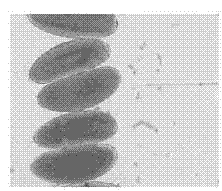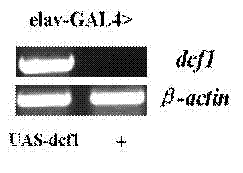Construction method of human dcf1 gene transgenic drosophila melanogaster model
A construction method and technology of puast-dcf1, applied in the field of construction of transgenic Drosophila model
- Summary
- Abstract
- Description
- Claims
- Application Information
AI Technical Summary
Problems solved by technology
Method used
Image
Examples
Embodiment 1
[0024] Example 1: Construction and verification of the Drosophila transgenic vector pUAST-dcf1
[0025] 1. In order to obtain the Drosophila transgenic vector pUAST-dcf1, first use the cDNA of human cervical cancer cell HeLa cells as a template for PCR amplification, and the primers are dcf1 primers (5'-CGGAATTCATGGCGGCGCCGAAGGGG AG-3' and 5'-GCTCTAGATTAAATTTCAGAATGAGCAA-3 ') to obtain the target fragment with a size of 972bp (the full length of the open reading frame of the dcf1 gene), and then digest it with EcoRI and XbaI, and collect the fragment for later use.
[0026] 2. Then cut the empty vector plasmid pWIZ with EcoRI and XbaI, and collect the large fragment for later use.
[0027] 3. Finally, connect the two fragments to obtain the Drosophila transgene vector pUAST-dcf1.
[0028] 4. If figure 1 The Drosophila transgenic vector pUAST-dcf1 constructed by EcoRI and XbaI double digestion identification, it can be seen that the transgenic vector pUAST-dcf1 released a t...
Embodiment 2
[0029] Example 2: Microinjection transgenic experiment and verification of transgenic fruit flies
[0030] 1. In order to obtain human dcf1 transgenic fruit flies, the principle of germ cell line transformation mediated by P factor was used to construct transgenic fruit flies by microinjection genetic engineering technology.
[0031] 2. Put the transgenic vector pUAST-dcf1 and the auxiliary plasmid into the glass microelectrode with an elongated opening at a certain concentration ratio, and inject the mixture into the newly produced Drosophila within 1 hour to remove the egg shell with the help of the pneumatic mechanical injection arm the tail of the fertilized egg, see figure 2 After the injection, the eggs were cultured in a humid box at 16°C.
[0032] 3. After the injected fertilized eggs hatched into larvae and then emerged into adults, they were mated with wild-type w1118, and the offspring whose eyes were red were selected as transgenic fruit flies. The selected UA...
Embodiment 3
[0034] Embodiment 3: Drosophila model of the present invention can be used as the tool in nerve cell research
[0035] 1. Drosophila has natural negative geotaxis. When the fruit fly is placed in a vertical tube, it will instinctively crawl upwards, and the crawling speed reflects the movement ability of the fruit fly. The experiment used different genes, the same number (10), the same eclosion days, and the same sex (male) Drosophila were anesthetized with carbon dioxide and moved into the same test tube (18 cm long, 1.5 cm in diameter), and the recovery began after 30 minutes at 25 ° C. experiment.
[0036] 2. Keep the test tube with fruit flies in a vertical state. At the beginning of the experiment, tap the test tube gently to make the fruit flies gather at the bottom of the test tube and then start timing. After 10 seconds, count the number of fruit flies at the top and bottom of the test tube quickly and count them. Make a good record, let the fruit flies recover for ...
PUM
 Login to View More
Login to View More Abstract
Description
Claims
Application Information
 Login to View More
Login to View More - R&D
- Intellectual Property
- Life Sciences
- Materials
- Tech Scout
- Unparalleled Data Quality
- Higher Quality Content
- 60% Fewer Hallucinations
Browse by: Latest US Patents, China's latest patents, Technical Efficacy Thesaurus, Application Domain, Technology Topic, Popular Technical Reports.
© 2025 PatSnap. All rights reserved.Legal|Privacy policy|Modern Slavery Act Transparency Statement|Sitemap|About US| Contact US: help@patsnap.com



